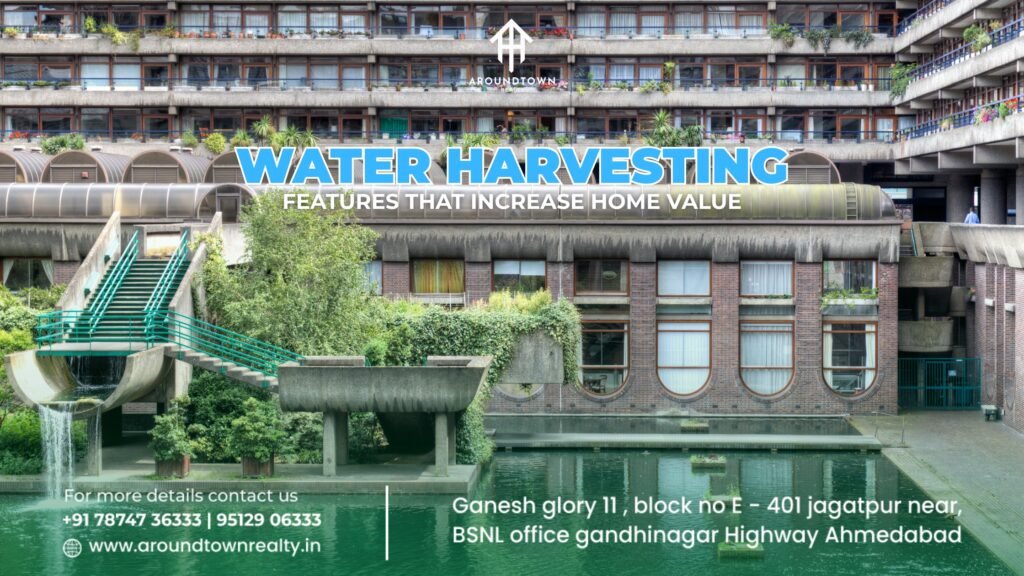Introduction: Water Harvesting Features That Increase Home Value
In a country like India, where water scarcity is a pressing issue in both urban and semi-urban regions, the demand for sustainable water solutions in residential spaces is gaining momentum. From Chennai to Ahmedabad and Gurgaon to Pune, water management is becoming a key metric in determining a home’s long-term livability—and its market value.
Among all sustainability initiatives, rainwater harvesting (RWH) and greywater recycling are proving to be not just eco-conscious solutions, but also value-enhancing assets in real estate.
Buyers today don’t just look at square footage and balconies. They want homes that can survive summer droughts, sustain a garden year-round, and reduce dependency on expensive tanker water.
This blog dives deep into how water harvesting features can increase home value, what systems are worth installing, how builders are incorporating them, and what buyers should watch out for in 2025 and beyond.
1. Why Water Harvesting Matters in 2025
Water scarcity has evolved from an environmental concern into a real estate priority. The average Indian metro home faces:
- Limited municipal water supply
- Skyrocketing costs of private water tankers
- Regulatory scrutiny over groundwater usage
This has made on-site water harvesting systems a crucial feature in modern residential projects, especially in water-stressed cities like:
- Bengaluru
- Jaipur
- Hyderabad
- Ahmedabad
In response, developers and homeowners are now viewing water conservation systems as smart investments that ensure:
- Long-term water security
- Reduced operational costs
- Improved property valuation
2. What Is Rainwater Harvesting (RWH)?
Rainwater harvesting is the process of collecting, filtering, and storing rainwater that falls on rooftops, terraces, or open areas for future use.
A typical residential RWH system includes:
- Catchment areas (terrace, paved areas)
- Downpipes and first-flush devices
- Filtration units
- Storage tanks or groundwater recharge pits
This water can be used for:
- Gardening
- Toilet flushing
- Washing vehicles
- Even potable use after proper treatment
The result? Reduced strain on municipal supply and a 30–50% cut in monthly water expenses.
READ THIS FOR MORE, Top Design Features That Increase Home Value Instantly
3. How Water Harvesting Adds Value to Homes
a. Cost Savings on Water Bills
Properties with functional RWH systems can save thousands annually on water bills. For larger villas or societies, this number scales quickly—making such homes financially sustainable.
b. Appeal to Eco-Conscious Buyers
Millennials and Gen Z buyers, especially in Tier-1 cities, are actively seeking green-certified homes. Water harvesting features often form a key part of green credentials that influence homebuying decisions.
c. Compliance with Regulations
Several Indian states have made RWH mandatory for buildings above a certain size. Properties that already comply are resale-ready and penalty-proof.
d. Improved Livability
A home with water harvesting can run longer without external water sources during shortages or summer droughts, increasing long-term comfort and resilience.
e. Premium in Builder Projects
Builders who offer water harvesting in apartments or gated communities are often able to charge a premium, especially if it’s paired with other eco-features like solar power or STP (sewage treatment plant).
4. Most Valued Water Harvesting Features in Modern Homes
1. Rooftop Rainwater Harvesting Systems
- Collects and redirects rainwater into recharge wells or storage tanks
- Ideal for villas, row houses, and low-rise apartments
2. Percolation Pits and Soakaways
- Helps recharge groundwater tables
- Now mandatory in several states for new construction
3. Underground Storage Tanks
- Stores large volumes of filtered rainwater
- Can be integrated with pump systems for internal plumbing
4. Smart Filtration Units
- Auto-cleaning filters reduce maintenance
- Ensures cleaner water enters tanks or borewells
5. Greywater Recycling Systems
- Treats used water from sinks and showers
- Reuses it for gardening or flushing—reducing overall water demand by up to 40%
6. Rain Gardens and Recharge Trenches
- Aesthetic landscaping + functionality
- Captures stormwater run-off and naturally filters it
5. Builder Adoption in Indian Real Estate
Leading developers are now integrating RWH and water conservation systems as part of their “green living” pitch. Examples include:
- Godrej Properties and Mahindra Lifespaces offering LEED and IGBC certified projects
- Ahmedabad’s South Bopal projects offering villa clusters with private water harvesting tanks
- Bengaluru’s large communities combining STPs + RWH + greywater systems for 360° water management
These features are not just sustainability markers—they’re also marketing differentiators that attract a premium set of buyers.
6. What to Check as a Homebuyer
Before investing in a home that claims to have “rainwater harvesting,” verify the following:
✅ Is the RWH system functional, or just on paper?
✅ Are there visible collection pipes, filtration units, and recharge pits?
✅ Is it integrated into the building’s water supply or groundwater recharge system?
✅ Does the RWA or society maintain and clean the system regularly?
✅ Is there a way to track water savings through smart meters or apps?
In many cases, systems are built for compliance but not maintained—so your due diligence matters.
7. Retrofitting RWH in Existing Homes
Even if you’re in an older apartment or villa, installing a basic RWH setup is feasible. Retrofitting involves:
- Adding collection pipes from terraces
- Installing a basic filter unit
- Digging a percolation pit or connecting to a recharge bore
The upfront cost is modest (₹20,000–₹1,00,000) but pays off within a few seasons through reduced water bills and fewer tanker requirements.
8. Impact on Property Resale Value
Homes with fully operational water harvesting systems often enjoy:
- Higher buyer interest (especially among eco-conscious families)
- A 5–10% premium during resale or rental negotiation
- Quicker sale timelines, particularly in water-scarce regions
In cities where water access defines quality of life, this feature is becoming non-negotiable.
9. Government Incentives and Mandates
Many urban local bodies in India offer:
- Property tax rebates for homes with verified water harvesting systems
- Fast-track building approvals for RWH-compliant plans
- Fines or occupancy delays for non-compliance in cities like Delhi, Bengaluru, Ahmedabad, and Jaipur
This further incentivizes buyers and developers to opt for sustainable water features.
10. Water Harvesting + Smart Home = Future-Ready Living
The new wave of homebuyers wants convenience, sustainability, and control. That’s why modern homes are integrating RWH systems with:
- IoT-based water level indicators
- Automated water flow controllers
- Mobile alerts for overflow or filter clogging
This fusion of green living and smart tech is what truly increases home value in 2025.
Conclusion: It’s More Than Just a Tank—It’s an Asset
Rainwater harvesting isn’t just a sustainability checkbox—it’s a value multiplier in Indian real estate. As cities grow denser and water becomes scarce, buyers and tenants will increasingly prioritize homes that offer water independence and cost efficiency.
Whether you’re a homeowner, investor, or developer, integrating water harvesting features is no longer optional. It’s a future-proof decision that improves livability and commands better returns.
Looking for Water-Smart Homes in Ahmedabad?
AroundTown Realty helps you discover properties with water harvesting systems, smart green infrastructure, and sustainability features—in Ahmedabad’s most promising neighborhoods.
Book a site visit with us today and invest in a home that values water—and your future.
FAQs on Water Harvesting in Residential Properties
- Is rainwater harvesting mandatory for residential buildings in India?
Yes, in many cities like Chennai, Delhi, and Ahmedabad, it is legally required for buildings above a certain size or floor area. - How much does it cost to install rainwater harvesting in a home?
Depending on the scale, it can range from ₹20,000 for basic setups to ₹2–5 lakhs for large-scale systems. - Can harvested rainwater be used for drinking?
Yes, but only after advanced filtration or UV treatment. Otherwise, it’s best used for non-potable purposes like gardening and flushing. - Does RWH help increase groundwater levels?
Absolutely. Recharge pits and percolation trenches help replenish underground aquifers over time. - Is water harvesting only relevant in drought-prone areas?
Not at all. Even in high-rainfall areas, harvesting helps reduce dependence on municipal water and prevents waterlogging.









